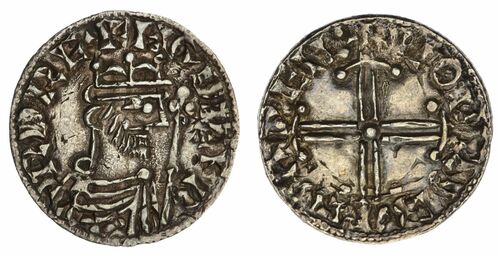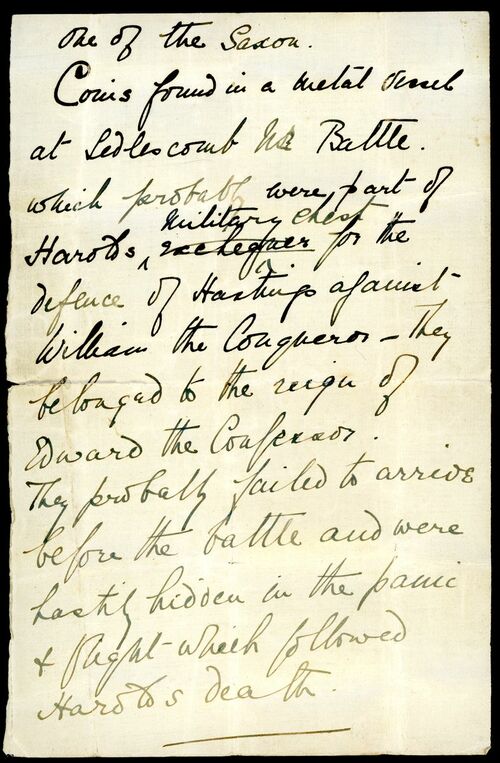Auction: 23005 - The "Haddenham" Collection of English Coins
Lot: 301
The 'Haddenham' Collection of English Coins | Edward the Confessor (1042-1066), 'Hammer Cross' Type, Penny, 1059-1062, Bath, Godric, + EADPAR-RD RE, crowned, draped and bearded bust right, trefoil-tipped sceptre before, rev. + GODRIC ON BAÐEN: voided short cross with each limb terminating in incurved segment of circle, 1.33g [20.53grns], 3h (Hildebrand - [Type G]; Freeman 28; SCBI 24 [West Country], 707-708 same dies; SCBI 42 [South Eastern ~ Sedlescombe Hoard], 1418 same dies; Lockett I, 842a same dies; cf. H A Parsons [BNJ, 1921], p. 40; North 828; BMC XI; Spink 1182), legends doubled with further die clashing, otherwise lightly toned, and of good metal, the attribution and pedigree certain, with only thirteen coins of this type known to Freeman for Bath (10 of Osmær; 3 of Godric) of which all of the latter are in Museums, presumed UNIQUE to commerce thus
Provenance
Warwick & Warwick 748, 20 August 2014, lot 354 - £343
with accompanying note of Victorian-era stationery, stating:
"One of the Saxon Coins found in a metal vessel at Sedlescombe [near] Battle, which probably were part of Harolds military chest [exchequer] for the defence of Hastings against William the Conqueror - They belonged to the reign of Edward the Confessor. They probably failed to arrive before the battle and were hastily hidden in the panic & flight which followed Harold's death."
Sedlescombe Hoard (1876), deposited, c. 1066
~ Found by a labourer in a small iron pot whilst digging a drain in a meadow near the village of Battle on 26 August 1876. G S Hill, writing in the Numismatic Chronicle (1879, pp. 154-156), stated: "Within [much oxidised pot] was part of a leather bag, containing a pint of small old coins, silver pennies of four different sorts, but all of Edward the Confessor, who reigned A.D. 1042 to 1066. The manor in which they were found is said to have belonged to Earl Godwin, father of King Harold II. Some of the coins were very brittle and broken." Whilst many were dispersed before Treasure Trove stepped in, it is believed as many as 3,000 coins originally complemented the hoard. The local antiquarian Major Boyce Harvey Combe FSA exhibited four coins at the meeting of Society of Antiquaries in June 1877.
Anthony Freeman noted: The recorded moneyers are Aegelmær, Eorlewine, Godric, Osmær and Wædel. This material enables a clear pattern to be identified of Bath as a two-moneyer mint, its needs met initially by Ægelmaer and Waedel (both of whom worked prior to Edward's accession), and their respective successors Osmær and Godric. Osmaer works into the post-Conquest period, but Godric is succeeded by Eorlewine in the Hammer Cross type. The absence of coins from the Pyramid type and from Harold II's reign marks a change in the mint's character. Thereafter minting appears to be erratic. Osmær continues at work but coins erratically (BMC types I, V and VIII in William's I reign), being joined in BMC III by Brungar and in BMC VIII by Ægelmær and possibly Godesbrand.
The stability of size and degree of continuity among moneyers are impressive. There are no single-type moneyers and the mint appears free from whatever factors may have determined the changes in moneyer complement at neighbouring mints, such as Gloucester or Bristol. Bath's moneyers appear to pursue their career exclusively in the service of the mint, and the names of Ægelmaer, Eorlewine, Osmær and Wædel are unique in Edward's reign to Bath; except in so far as it must conform broadly to the requirements of minting policy, the Bath mint appears to function in complete isolation.
Subject to 20% VAT on Buyer’s Premium. For more information please view Terms and Conditions for Buyers.
Sold for
£2,600
Starting price
£200







